Book contents
- Frontmatter
- Contents
- List of contributors
- Foreword
- Acknowledgments
- 1 An overview of child and adolescent mental health needs in the juvenile justice system
- 2 Psychiatric disorders of youth in detention
- 3 Disproportionate minority confinement
- 4 Police interrogation of youth
- 5 Assessing children's competence to stand trial and to waive Miranda rights: new directions for legal and medical decision-making in juvenile courts
- 6 The etiology of antisocial behavior: biopsychosocial risk factors across development
- 7 Substance abuse in youth offenders
- 8 Suicide and delinquent adolescents
- 9 Juvenile sex offenders
- 10 Educational needs of youth in the juvenile justice system
- 11 Science and the juvenile death penalty
- 12 Medical issues regarding incarcerated adolescents
- 13 Mental health screening and assessment in juvenile justice
- 14 Psychological testing in juvenile justice settings
- 15 Psychopharmacology and juvenile delinquency
- 16 Evidence-based treatment for justice-involved youth
- 17 Community alternatives to incarceration
- 18 Innovative problem-solving court models for justice-involved youth
- 19 Ethical issues of youthful offenders: confidentiality; right to receive and to refuse treatment; seclusion and restraint
- 20 Post-adjudicatory assessment of youth
- Index
- References
15 - Psychopharmacology and juvenile delinquency
Published online by Cambridge University Press: 11 August 2009
- Frontmatter
- Contents
- List of contributors
- Foreword
- Acknowledgments
- 1 An overview of child and adolescent mental health needs in the juvenile justice system
- 2 Psychiatric disorders of youth in detention
- 3 Disproportionate minority confinement
- 4 Police interrogation of youth
- 5 Assessing children's competence to stand trial and to waive Miranda rights: new directions for legal and medical decision-making in juvenile courts
- 6 The etiology of antisocial behavior: biopsychosocial risk factors across development
- 7 Substance abuse in youth offenders
- 8 Suicide and delinquent adolescents
- 9 Juvenile sex offenders
- 10 Educational needs of youth in the juvenile justice system
- 11 Science and the juvenile death penalty
- 12 Medical issues regarding incarcerated adolescents
- 13 Mental health screening and assessment in juvenile justice
- 14 Psychological testing in juvenile justice settings
- 15 Psychopharmacology and juvenile delinquency
- 16 Evidence-based treatment for justice-involved youth
- 17 Community alternatives to incarceration
- 18 Innovative problem-solving court models for justice-involved youth
- 19 Ethical issues of youthful offenders: confidentiality; right to receive and to refuse treatment; seclusion and restraint
- 20 Post-adjudicatory assessment of youth
- Index
- References
Summary
The miserable have no other medicine, but only hope.
William Shakespeare, Measure for Measure, Act III, Scene I.Introduction
Psychopathology among juvenile offenders is widely considered to be a significant problem and has been examined in recent, broad psycho-epidemiological studies (Teplin et al., 2002; Vermeiren, 2003; Wasserman et al., 2003; Vermeiren et al., 2006). These estimates of psychiatric illness may partially overestimate the prevalence of psychopathology among all offenders due to the fact that incarcerated juveniles are more likely to have illness and to have greater morbidity than first-time offenders or those in diversion programs. Nevertheless, the high prevalence rates for psychopathology among juvenile offenders should be a cause of concern. The best approach to this population entails taking a developmental perspective which takes into account that despite their crimes these children continue to mature, grow, and change in profound ways (Frick, 2006; Karnik et al., 2006).
Treatment of confined juveniles has certain ethical and moral problems due to the unique consent and assent issues at play for this potentially vulnerable group of patients. A recent consensus report recommends behavioral management and psychotherapy be used where clinical indications clearly allow these as first-line interventions (Pappadopulos et al., 2003). Only after these approaches have failed should psychopharmacological interventions be considered (Pappadopulos et al., 2003; Schur et al., 2003). For example, an acutely manic offender who presents with pressured speech, aggressive behavior, and delusional thoughts would merit anti-psychotic medications for stabilization followed by psychotherapy and medications if needed, whereas a youth offender presenting with mild anxiety symptoms might merit psychotherapy as initial treatment.
Keywords
- Type
- Chapter
- Information
- The Mental Health Needs of Young OffendersForging Paths toward Reintegration and Rehabilitation, pp. 308 - 339Publisher: Cambridge University PressPrint publication year: 2007



